Bustling, hustling, grimy and beautiful: Naples Italy, the third largest city in the country, brims with passion and energy. Its food and music are world famous but the city has many hidden treasures too. It’s a great destination for a city break or as a base for exploring the stunning coastline of Campania. Here’s our top things to see in Naples Italy, from ancient wonders to contemporary art, crafts, music, local food and the best day trips from Naples too.

This post contains affiliate links, this means that I may receive a commission at no cost to you if you click a link and make a purchase.
Things to do in Naples Italy in 6 days
I visited Naples in southern Italy with my two sons when they were students. And the city does have a buzz and an edginess that teenagers and young adults will appreciate. The presence of Roman times lingers too, for me it’s as palpable as in Rome itself. Plus there’s an active volcano looming over the bay. And the food is fantastic!
Naples Italy was a hugely important European city for centuries. Spanish, Austrian and French rulers all left their mark and helped give the city its unique character. All in all, there’s plenty of things to do in Naples Italy and lots to see and explore outside the city too.
Tours to Book Ahead in Naples Italy
If you’re in a hurry and looking for inspiration bear in mind that the best tours get booked up in advance. We snapped up a private guide for Pompeii six weeks before our visit in September and I’m so glad we did.
Plan ahead for these tours from Naples:
An archeologist-led private guided tour at Pompeii. Pompeii, engulfed by the eruption of Mount Vesuvius in Roman times, is a whole ancient town in ruins – and without signposts. An expert guide can really make a difference here. He or she will direct you to the key sights and really bring the ruins to life for you. This is one outing where I really urge you to get a good guide!
Equally you could combine Pompeii with a visit to Mount Vesuvius. It’s possible to do both in the same day but an organised tour will definitely alleviate the stresses of negotiating the local buses and trains. Check out this Guided tour at Pompeii with a transfer to Mount Vesuvius
If we’d had a little more time I’d have loved to re-visit the legendary Amalfi coastline. Naples is so close it’s another must-see. You can add on a boat ride to Amalfi too. A boat trip from Naples along the Amalfi coastline with a stop off at Positano.
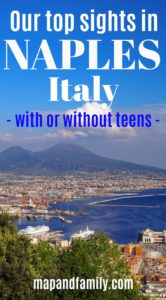
Like this post? Please Pin this to Pinterest to save and share
11 Amazing Things to Do in Naples Italy
We spent 3 days in Naples and took 3 additional day trips. These are our top things to see in Naples Italy: a starter kit for this fascinating, colourful and complex city.
Explore the Historic Centre of Naples
The streets here are narrow and cobbled, flanked with tall buildings and flagged with laundry dangling from iron balconies. Natural light is in short supply but there’s plenty of colour at ground level in the closely packed shops and stalls.
The area bustles with people pausing for snacks and waiters whisking in and out of buildings balancing trays of expressos. It’s a great place to wander and get a feel for the city.
Watch out though: those paved narrow streets look like they might be pedestrianised until suddenly a scooter or taxi materialises, beeps its horn, weaves fast through the passers by and zooms away again. The scooter may be carrying a business man, it may be transporting an entire family plus dog – in whichever case it won’t be dawdling. Traffic is a bit of a hazard in Naples.
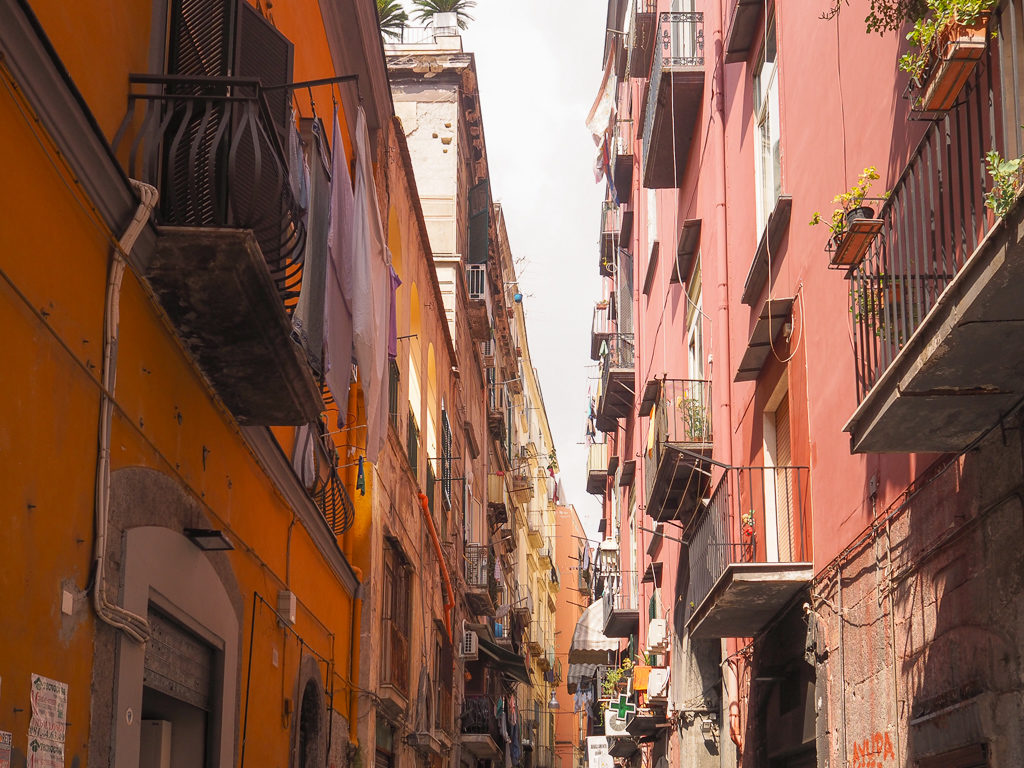
The historic center of Naples is a UNESCO World Heritage site. We strolled around the grid of streets established by the ancient Greeks and Romans. Via San Siagio Dei Librai is also called the Spaccanapoli because it splits Naples in half.
Via Dei Tribunali has ancient arcades in which passers by can shelter from the scooters with a fistful of pizza or a cone of deep-fried deliciousness.

Linking the two is Via San Gregorio Armeno, a magnet for tourists – see why below. None of it has been gentrified. There might be a familiar looking H&M on neighbouring Via Toledo but the Centro Storico is resolutely as it was.
We took in the street scenery: small shops, historical buildings. At a corner we stopped off at uber-trad Caffe Ciorfito for cappuccino and cornetti. Later, as we passed the Conservatorio di Musica, the soaring notes of an aria drifted out of an upstairs window and down the ancient street. It was a trumpet solo when we passed again later in the week.
Book a walking tour of Naples. This Private Food Tour with a Local offers 10 tastings of local specialities – with veggie alternatives – as well as city highlights. It has great reviews.
Go shopping in the street of nativity scenes
Whether or not you’re keen to buy traditional Neapolitan nativity scenes, Via San Gregorio Armeno is a must see in Naples Italy. Little terracotta figures were made here in classical times as temple offerings, but the presepi (nativity cribs) business really took off during the Bourbon era of the 18th century. Aristocrats began to collect the figures and arrange them into festive tableaux of Italian village and market life.
The craftsmen are still thriving in this little street, also known as Via dei Presepi. Neapolitan families visit every year to buy new figures to add to their Christmas decorations.
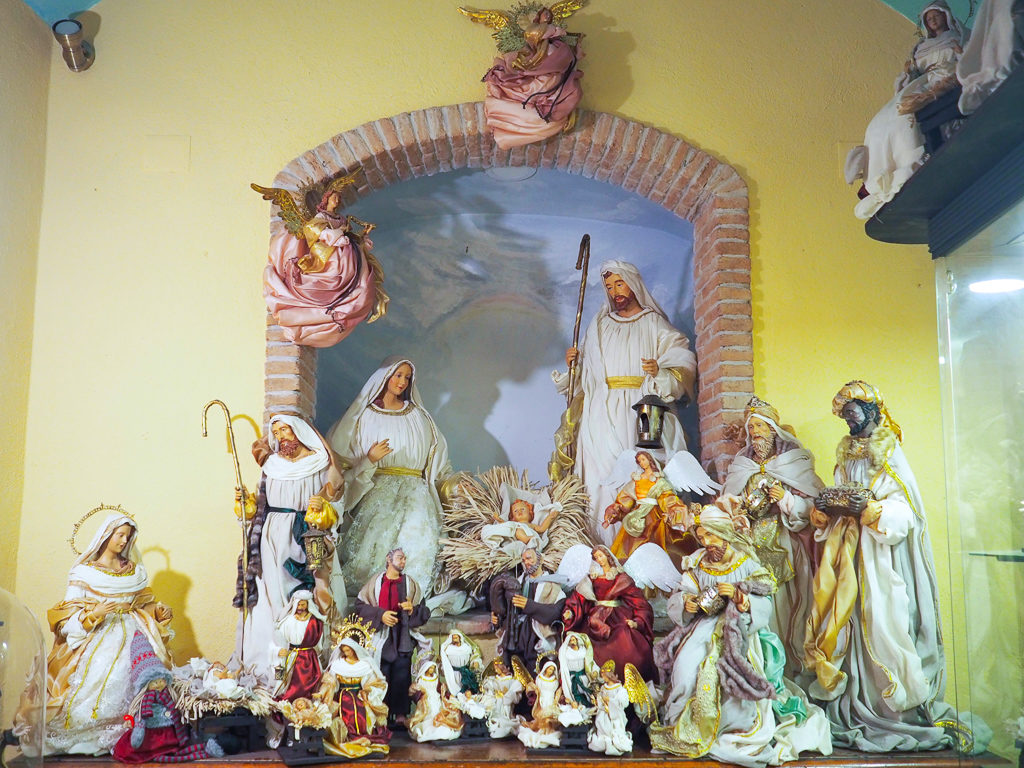
It’s a lovely place to find traditional Italian souvenirs – but that’s only half the story. This is Naples after all. In a odd mix of holy and irreverent, beautifully carved shepherds and wise men join ranks with pop culture heroes and villains: politicians, TV personalities and the entire Napoli football team.

We spent quite a while browsing the stalls and dipping in and out of the little workshops. You could populate an entire 18th century Italian village with the figures from one shop, right down to perfectly detailed baskets of fruit and fish.
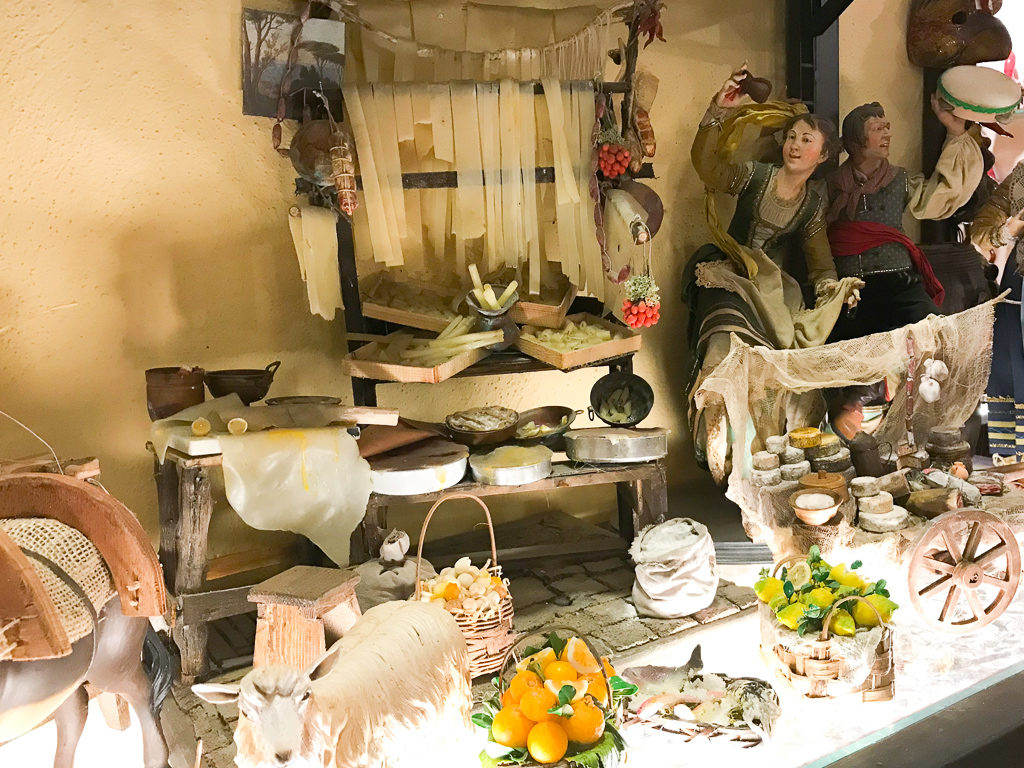
Then pop outside to the next door stall for a figure of Donald Trump or a robe-lifting monk! And let’s not dwell on the rolls of politician loo paper ….
Explore Underground Naples
There’s a whole other world beneath the streets of Naples. Roman markets, viaducts and cisterns, catacombs, WW2 air-raid shelters, even abandoned vintage cars. You’ll want to add a trip below the surface of the city to your Naples Italy what to do list.
We went underground at the Basilica of San Lorenzo Maggiore. It’s at the top end of Via San Gregorio Armeno in the historic centre. The church itself is a fine medieval building at the centre point of ancient Naples. But pop downstairs and you find yourself first in medieval times and then, another flight down, in a Roman marketplace. This is a market building from the 4th century BC with a bakery, a laundry and a bank.
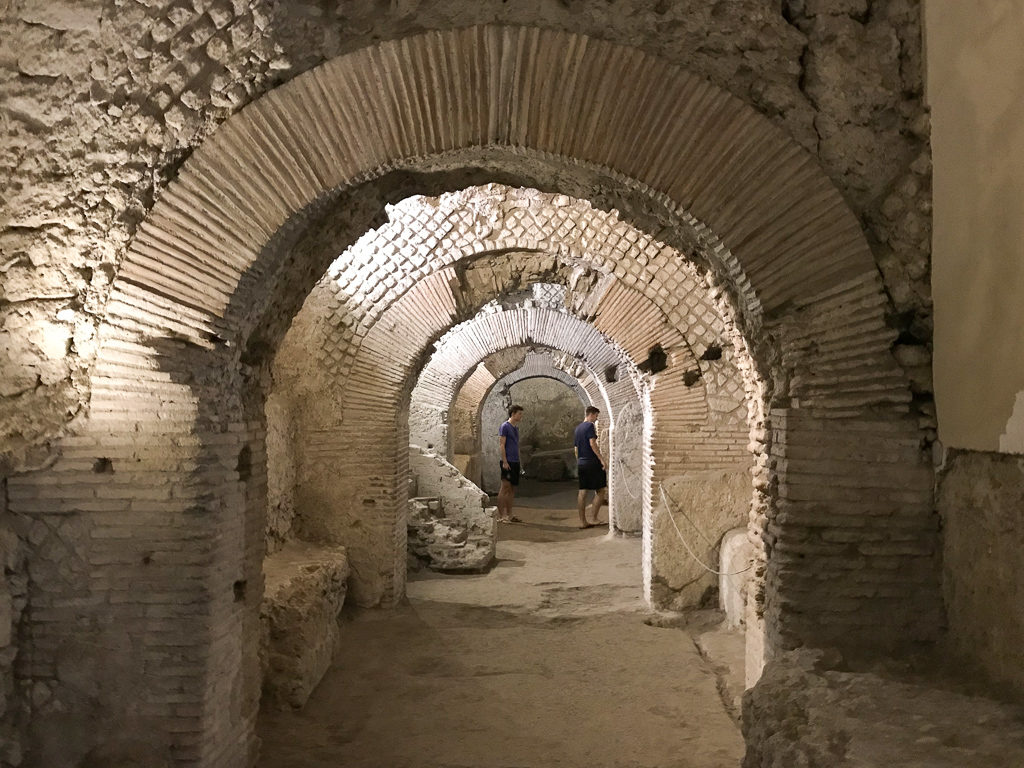
Or visit Napoli Sotterranea which is based in Piazza San Gaetano, just round the corner from San Lorenzo Maggiore. This is a guided tour that takes you 40 metres below ground to see Greek water cisterns, a Roman theatre and WW2 air raid shelters. There’s even an optional candlelit section. Click here to pre-book a Napoli Sotterranea tour.
The Bourbon Tunnel or Galleria Borbonica, is a cavernous 18th century cistern, a shelter during bombing raids in WW2 that still contains some ancient impounded cars.
There’s a lot going on under the streets of Naples. Book ahead for tours of the underground tunnels, ancient city or catacombs. Here’s a selection of Naples underground tours.
Finally don’t miss the Metro’s Art Stations, they are some of the most beautiful metro stations I’ve seen. Toledo was our local stop and is dazzling. If only all tube stations could be like this one.
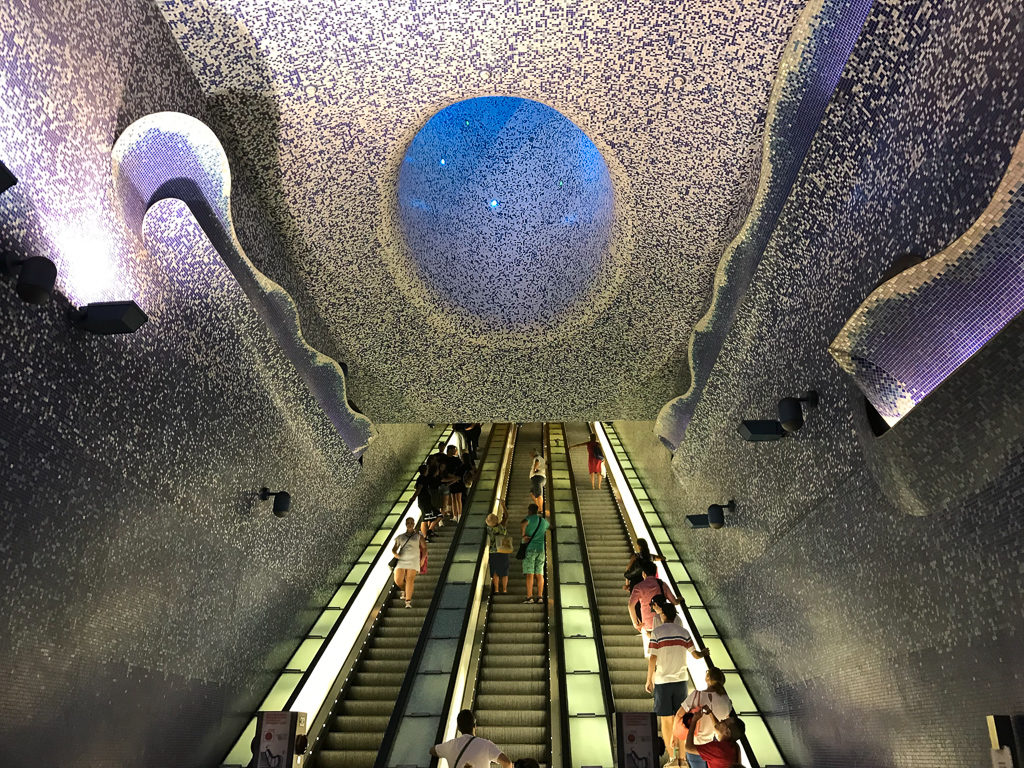
Cultural Things to do in Naples Italy
These key Naples Italy sights reflect the city’s rich history across the centuries. All three are in the historic centre so easy to include when planning an itinerary.
Cappella Sansevero: astonishing sculptures
There are plenty of churches worth visiting in Naples but we’d heard about one in particular. Museo Cappella Sansevero, in the historic centre of Naples, is a small private chapel from the eighteenth century. What’s most interesting and even mysterious about it are the sculptures inside, commissioned by Raimondo di Sangro. A nobleman and Prince of Sansevero he was a soldier, writer and patron with an interest in science and … alchemy!
The Veiled Christ is the carving that everyone comes to see: a sculpture of the body of Christ covered in a fine translucent shroud. What makes it special is that the whole piece, veil included, has been carved from a single block of marble. The detailing is so breathtaking that legend has it that the veil was the result of a secret formula to turn cloth to marble. No one is allowed to take photos so you really do have to see it yourself.
National Archeological Museum: ancient treasures
Naple’s National Archaeological Museum has one of the best collections in the world. We wanted to see some of the wall paintings, mosaics and statues from the Pompeii excavations. It was a chance to fill in the gaps from our tour of the original villas.
The museum itself was originally a barracks – a very splendid one with sweeping stairways and lofty ceilings. This is just as well because the ground floor is home to some towering statues from the Greek and Roman period. The muscular Farnese Hercules and giant Farnese Bull are just some of them.
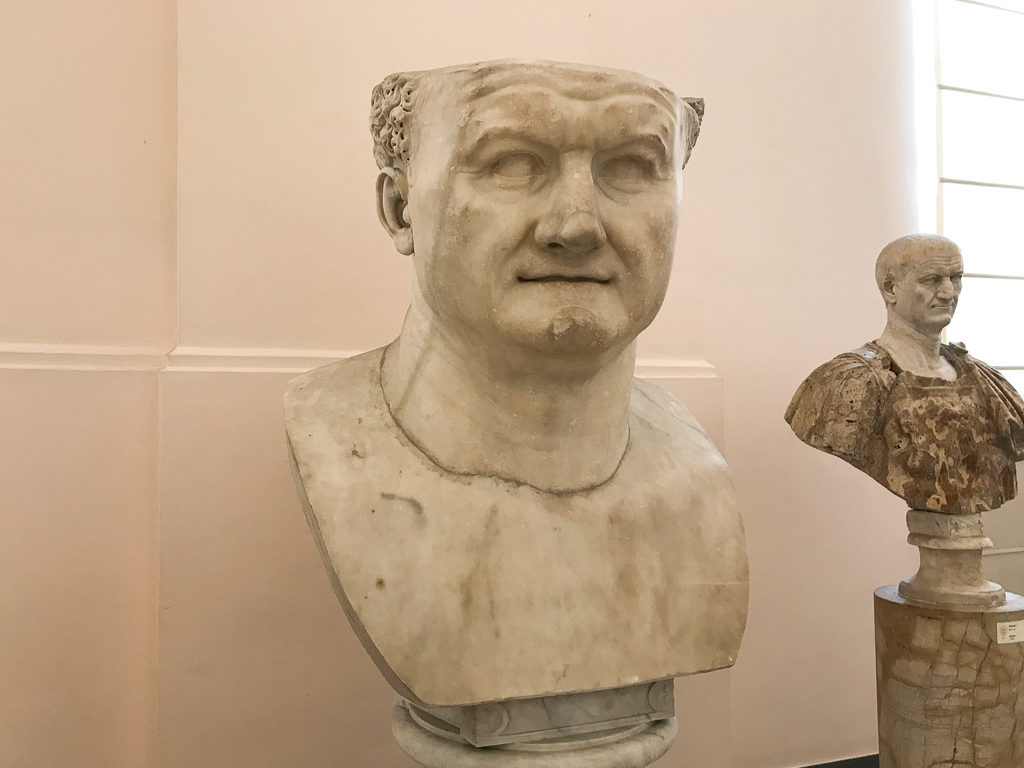
I liked the busts of the Roman emperors: there are a couple of Vespasian that seem real enough for you to recognise him out in the street. Upstairs, in a kind of ancient poets’ corner, you come face to face with the extravagantly wrinkled Homer, of Odyssey fame.
The most giggled-about area of the museum is the infamous Gabinetto Segreto, a not-so-secret chamber where they’ve stashed all the p*rn from Pompeii. This does underline the point that the Romans were ‘not like us,’ certainly in terms of art considered suitable for dining room walls. You’ll also take away a whole new mental picture for the phrase ‘with bells on’.
MADRE: contemporary art
We went to MADRE, Naples’ Museum of Contemporary Art later that day. Housed in an old palazzo (of course) it has a small and brilliant collection of modern art and installations by Jeff Koons and Anish Kapoor amongst others.
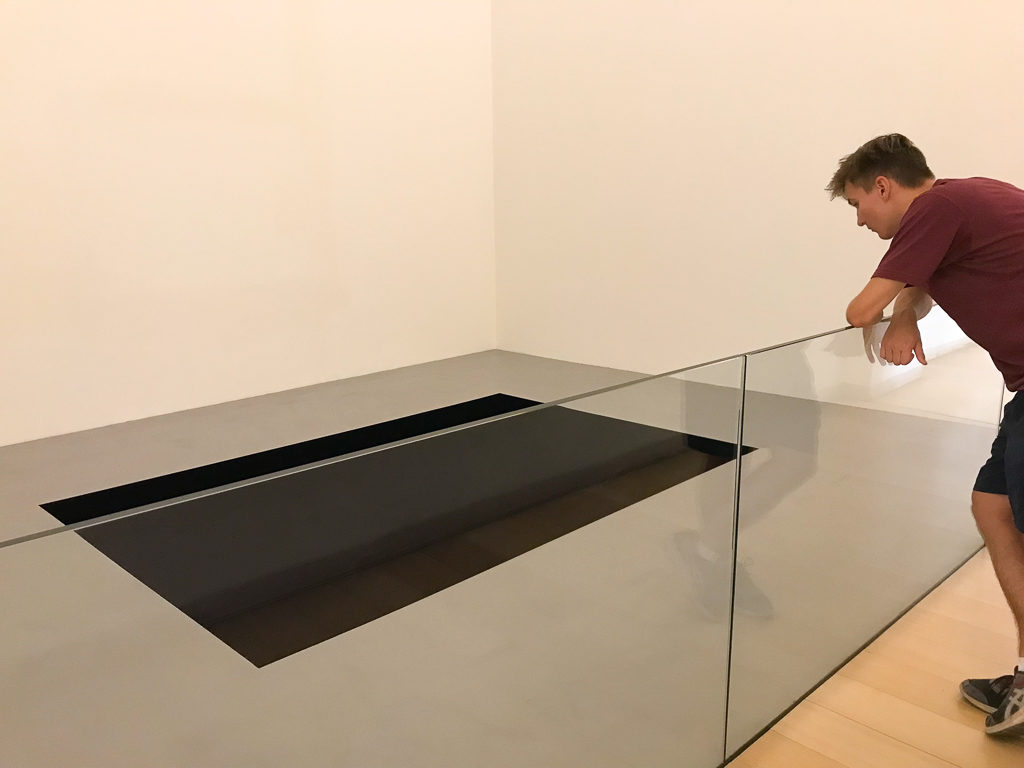
In a temporary exhibition ancient artifacts were juxtaposed with contemporary work that referenced the eruption of Vesuvius – but that hardly begins to describe it. Dense and well-translated text supports each installation and there’s a lot to take in. We wished it hadn’t been our second culture fix of the day! Come with a clear head and an open mind. By the way, we totally missed Mimmo Paladino’s horse sculpture – it’s up on the roof.
Test an old Naples Trick in Piazza Plebiscito
Named to mark the unification of Italy in 1860 the spacious and elegant Piazza del Plebiscito is just south of the historic centre, on your way to the waterfront. It’s handy for various Neapolitan must sees including the opera house Teatro di San Carlo, the beautiful historic shopping arcade Galleria Umberto 1 and equally elegant coffee house Gran Caffe Gambrinus. The pink-hued Royal Palace of Naples takes up a whole side of the square.
The piazza itself is pretty splendid, with curving colonnades that look quite a lot like Bernini’s St Peter’s Square in Rome and a centrepiece dome that’s clearly Pantheon-esque.
In front of the domed church of San Francesco di Paola stand two bronze statues of Bourbon kings on horseback. These are the focus of a famous Neapolitan trick.
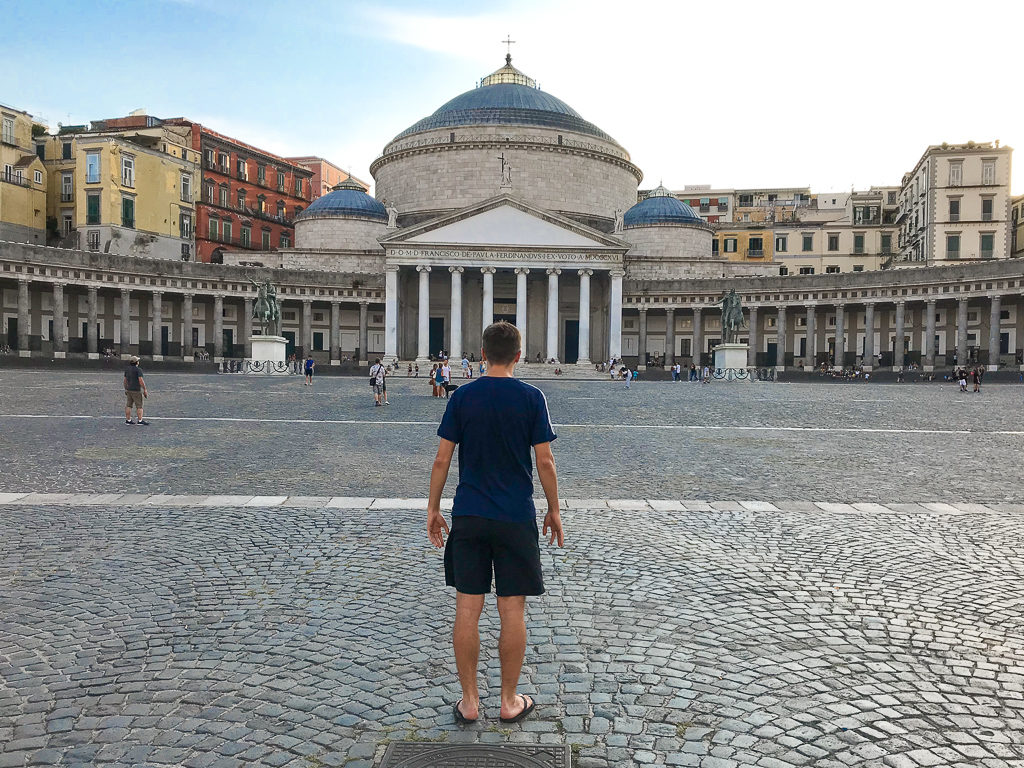
The test is whether you can walk straight across the piazza and between the two statues – blindfolded. It’s a longish walk, about 100 metres, but since the statues stand wide apart it doesn’t seem too difficult.
Nick tried it with his eyes closed and us hovering to stop him crashing into unwary passers by. The result was so peculiar that Ed and I had to have a go as well. The whole piazza has a hidden camber. It’s impossible to walk straight. Try it.
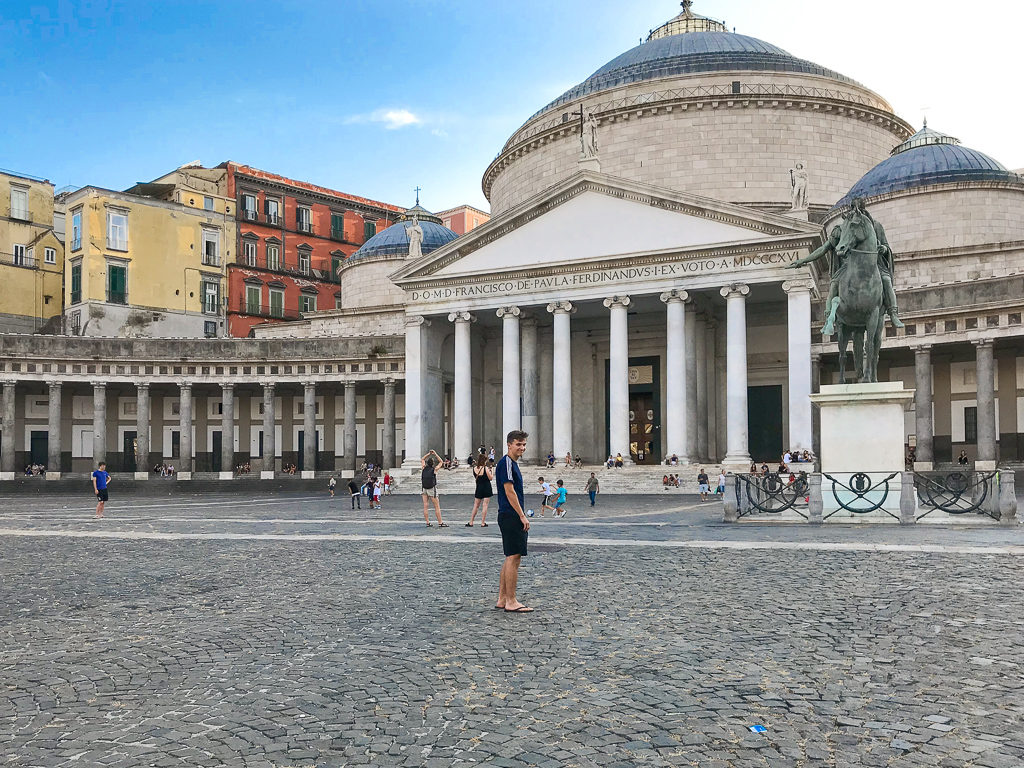
Listen to Traditional Neapolitan songs
To say Naples has a musical history would be a bit of an understatement. Famous for its opera and folk songs, it’s the birthplace of Caruso and O Sole Mio, possibly the best known melody in the world, which Gargarin hummed as he orbited Earth.
Napulitanata operates out of a renovated ex-taxi storeroom in a arcade opposite the Archeological museum. It’s a group of young musicians with a mission. They present traditional Neapolitan music and songs for locals and visitors alike in an intimate setting that’s more like a living room than a concert hall.
There’s a friendly welcome and a drink with nibbles for the audience who sit round the edge of the room. It’s fun, authentic, not at all ‘packaged’ – and helpfully introduced in English as well as Italian. You can book their Traditional Neapolitan Music Show here and watch some clips on their Facebook page here. Go before they get too famous!
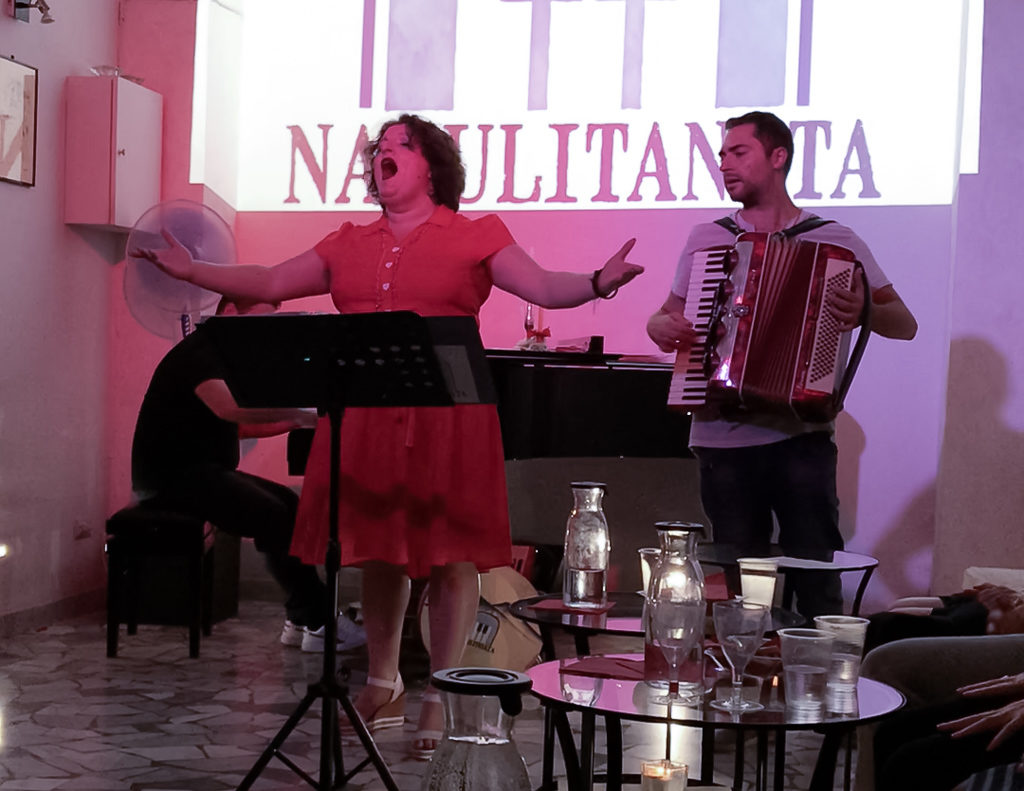
Enjoy the Food in Naples Italy
If you like to eat local food when you’re on holiday then you’ll love Naples. Unlike more touristy cities, where eateries proffer laminated menus in several languages with photos, most restaurants in Naples are primarily catering for Neapolitans. So you might struggle a bit to understand exactly what’s on your plate but it’s more likely to be authentic, reasonably priced – and delicious.
Everyone knows Naples is the birthplace of pizza, and possibly gelato too. But it also claims a stake in ragù, the meaty slow-bubbled vegetable and tomato sauce that in Naples dates from the 13th or 14th century. Taste some of the best ragù at Tandem in Via Paladino in the historic centre.
Make sure you eat an authentic Neapolitan pizza: it’s one of the top things to do in Naples Italy. And some would say this is the place to eat the best pizza in the world. Antica Pizzeria da Michele is one of the oldest pizzerias in the city, but we were daunted by the queue and had fabulous pizzas elsewhere.

Street food, of the traditional rather than the hipster variety, is a big thing in Naples. Pizza obviously, which is folded in on itself so it can be carried in one hand. But Neapolitans are also very fond of deep-fried snacks. Food stalls specialise in takeaway paper cones filled with warm and comforting potato croquettes, crispy vegetables or indeed, fried pizza. And the sweet pastries are epic. Arrive hungry and make plans to do lots of walking between meals!
Get a bird’s eye view of the city
On our last day in Naples we hopped on one of the funicular trains to catch a lift up the hill to Vomero. We emerged into another world of peaceful, airy tree-lined streets with hardly any beeping and zooming at all. Vomero is a residential area – I couldn’t find a postcard anywhere – and seems a million miles away from the hustle of Centro Storico. After popping into a supermarket to buy coffee to take home, we headed up to Certosa di San Martino via outdoor escalators (which inexplicably closed down at lunchtime).
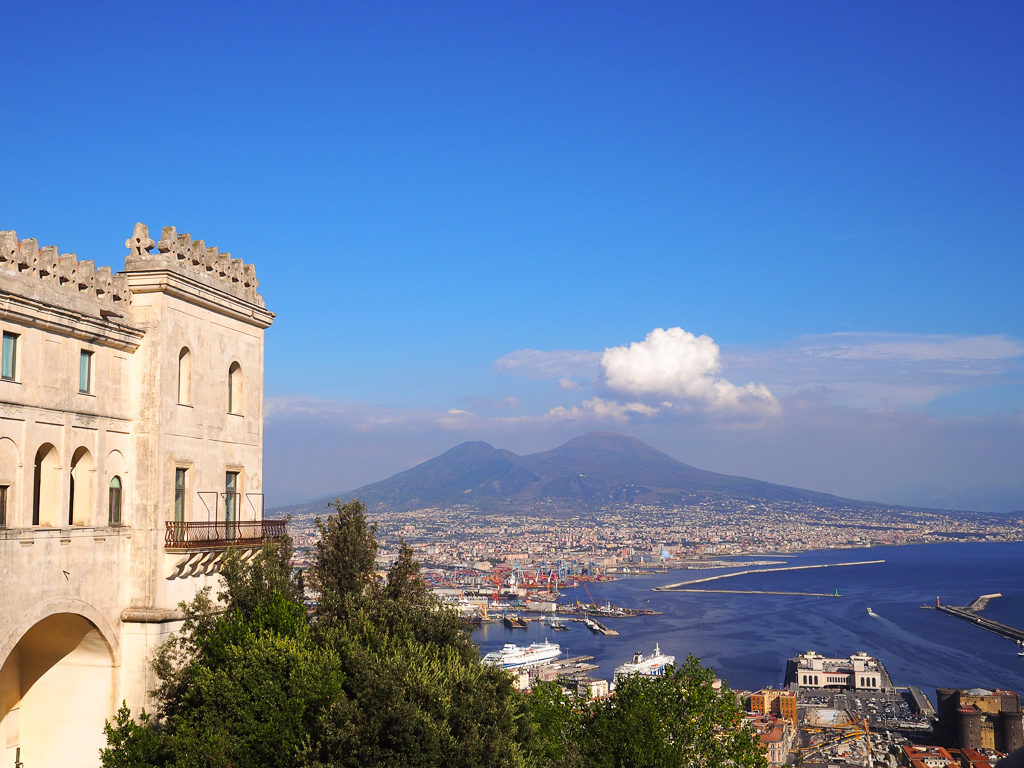
This monastery complex lies beside Castel Sant’Elmo. Both apparently have great views but we picked the Certosa for its garden terraces. There’s a museum inside including carriages, royal barges and a huge presepi display. Out on the terraces are glorious panoramic views of the city and the Bay of Naples. And mosquitoes. But this really is one of the top things to see in Naples Italy, simply for the amazing views of the bay and Vesuvius.

Walk the Pedamentina San Martino
We walked back into town down the Pedamentina San Martino, an ancient staircase that’s been hairpinning down the hill since the 1300s. More of a walkway than a flight of stairs it begins ignominously, with lots of broken glass underfoot, dropped by sightseers sitting on the wall of the Belvedere outside the Certosa. To be honest the best views are at the top and we did spend a lot of time watching our feet as we made our way down the 414 stairs, passing homes and even a B and B.
At the bottom of the steps it’s not obvious where to go. The answer we chose was a narrow steeply winding street with a couple of blind corners. This is clearly an enjoyable challenge for scooter riders but not so much for pedestrians. It led to Via Toledo via the hubbub of Quartieri Spagnoli and some fish stalls!
This would have been fun to do as part of a guided walk and I wish I’d known about this urban trek: Naples Contrasts and Panoramic Walking Tour which follows the same route and includes food tastings in the market.
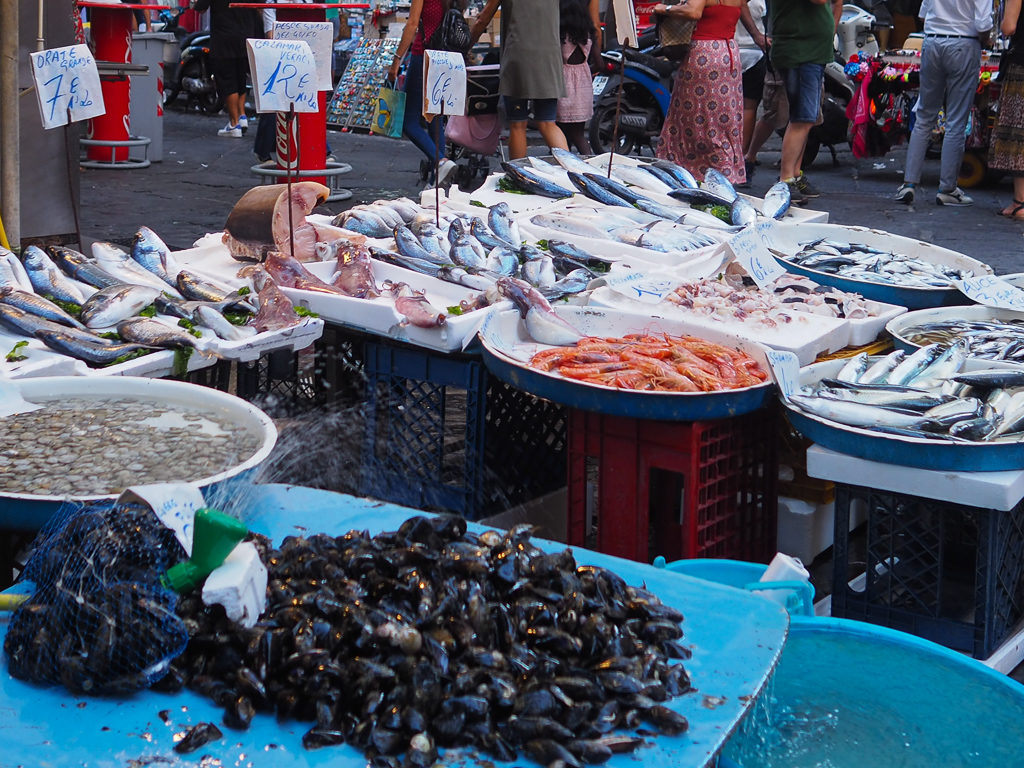
Planning an Italian city break?
Read about our trip to Rome and an autumn half-term break in Venice.
Naples Italy Places to Visit
Poised on the west coast of Italy, south of Rome, Naples is in Campania, one of the most beautiful regions of Italy. You could spend a week here and take a different day trip everyday. That’d be a shame because there’s plenty of things to see in Naples Italy, but it’s definitely worth organising at least one day out.
We did several day tours from Naples and I’d recommend them all. From archaeological sites to pretty seaside towns, tiny islands and a live volcano, there’s something to please everyone. Here’s an overview of our day trips from Naples and links to detailed posts.
Visit the ancient ruins of Pompeii from Naples
A busy Southern Italian port town, Pompeii was engulfed by volcanic ash after the eruption of Vesuvius in AD 79. This globally famous archaeological site is huge, breathtaking – and it takes a bit of unpacking. We spent a fascinating morning there on a private guided tour. Pompeii is a place where you really will benefit from a guide. Read about our visit to Pompeii Italy.
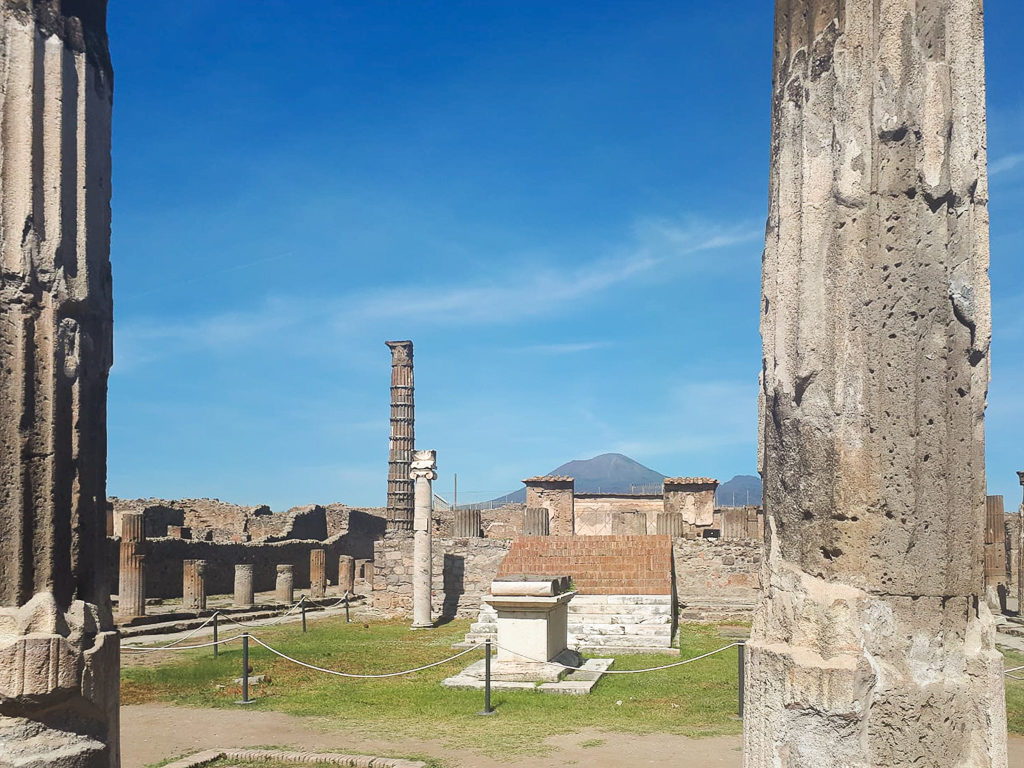
Walk up Mount Vesuvius
Climb to the top of the volcano responsible for the devastation of Pompeii. We visited Pompeii and Vesuvius in one day although it’s a bit of a push and doesn’t leave much time for lunch. But the view from the crater’s edge is fab. Pick a clear day.
The ascent takes about 30 minutes from the bus drop-off point which is (luckily) halfway up the mountain. You will need some suitable shoes as the path is gritty and rough round the edges – and of course it’s rather steep since you’re heading up the side of a volcano.
Despite the fact that Vesuvius is an active volcano, grapes have been grown on its fertile slopes since ancient Roman times and are used in the famous Lacryma Christi wines.
I’d love to try this Vesuvius and Wine Tasting Trip which combines an active morning of volcano climbing with a knowledgeable guide, followed by a wine tasting and lunch of local specialities at a vineyard on the slopes. Click here to check availability.
See Pompeii and Mount Vesuvius in 1 Day
We often like to do things at our own pace. But in this case we were lucky that our Pompeii guide travelled with us from Naples to the site and then gave us some detailed tips about transport to Mount Vesuvius. We managed to see both, properly, but we were very organised with train and bus timetables.
This guided tour has great reviews: Click here for details of Full day Pompeii and Vesuvius Tour
It includes a skip-the-line guided tour at the Pompeii site and an air-conditioned bus that smoothes the transfer to Vesuvius and then home again. There’s even a bit of lunch at Pompeii if you choose that option. It’s a tiring day of sightseeing, especially in hot weather, so it’s a bonus to know you have a trouble-free transfer back to Naples or Sorrento.
Visit Procida island from Naples
This lovely little island is only a 30 minute boat ride from Naples. The beautiful pastel-painted fishing village of Corricella was peaceful to the point of sleepy on the weekday we visited. After some pottering around we settled in on a quiet sunny beach with a fab restaurant. Read about our day trip to Procida here.
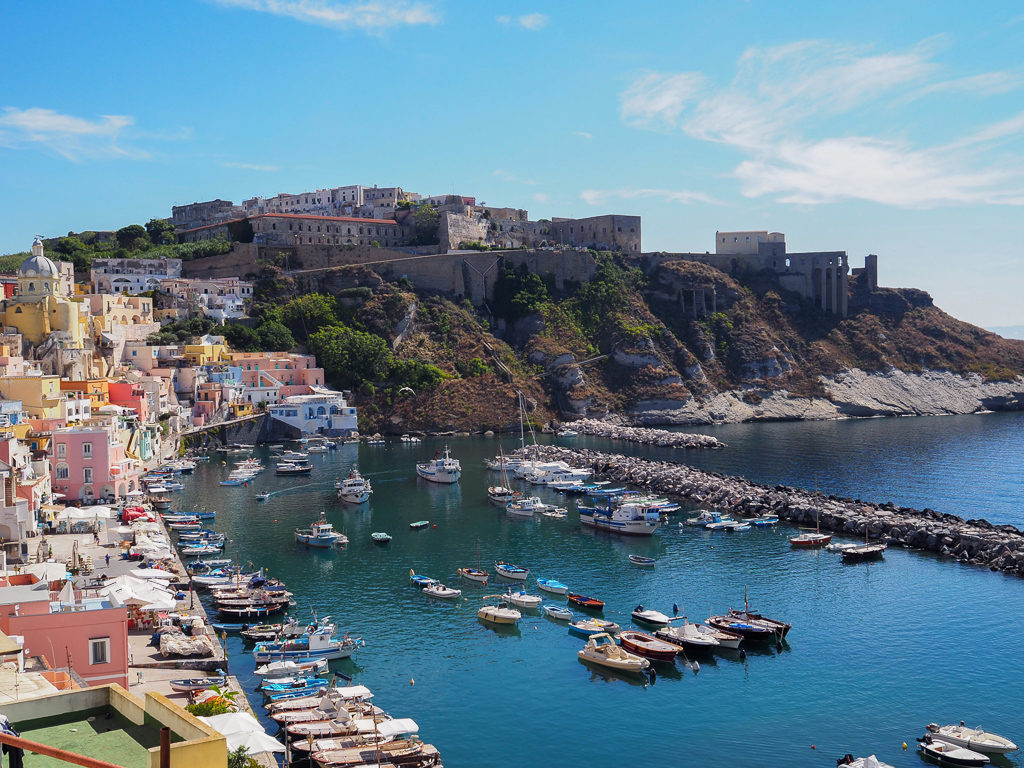
See the ruins of Herculaneum
If Pompeii whets your appetite for archeology or you’d prefer to dip into a smaller site, then visit Herculaneum. Another Roman town that met an abrupt end thanks to the eruption, it’s just a short train ride from Naples. Unlike Pompeii, Herculaneum wasn’t flattened. The shells of some of its two storey buildings are still standing. It gives an eerie sense of how a Roman town really looked 2000 years ago.
We visited both Herculaneum and Sorrento in one day, taking the train from Naples.
Visit Sorrento on the Amalfi coast
A traditional seaside town with cliff top views, Sorrento is an hour south of Naples and gateway to the glorious Amalfi coastline.
We spent an afternoon here after visiting Herculaneum. It was a flying visit but we still had time to find lunch with a view, relax, swim, and have a sunset aperitif before we caught the train ‘home’. By the way, you’ll be congratulating yourself that you’re staying in Naples since eating and drinking in Sorrento is noticeably more expensive.

Tour the Amalfi Coastline from Naples
The iconic Amalfi coast drive with it’s panoramic views of the Tyrrhenian Sea, plunging cliffs and achingly pretty coves is the stuff of legend. And that’s before you even consider the picturesque towns of Sorrento, Amalfi, Positano and Ravello. And it is all just an hour away from the city of Naples. We’ve visited a few times in the past so we didn’t go further than Sorrento on this visit.
If you have a day free then grab the opportunity to go see it.
Check out this Amalfi Coast Full Day Trip which takes in pretty Positano and the hillside village of Ravello (make sure you see the glorious views from the terraced gardens of Villa Rufolo and / or the Terrace of Infinity at Villa Cimbrone). It offers optional add-ons of a boat trip to Amalfi and lunch too.
Where to stay in Naples Italy
We stayed in the Centro Storico, the UNESCO protected historic centre. Most of the top things to see in Naples Italy are close by so its a great place to start your exploration. We were also close to the harbour, the sea views and Castel dell’Ovo. And our Airbnb was within walking distance of the buses and boats which we used to head out of town on day trips.
Staying close to the train station is a less desirable option in Naples since it’s an area that’s rougher round the edges.
Click here for a selection of hotels and apartments in Naples with Booking.com. You can set your preferred filters then scroll through the photos, descriptions and reviews to choose the accommodation you like best for your stay.
Is Naples Safe?
So much is written about whether or not Naples is safe for tourists. It’s certainly earned a reputation for organised crime and grime over the years. But recently much has been done to regenerate the city. Obviously I can’t give a definitive answer about whether or not you should go, but we loved it, so here are some tips based on our visit.

Firstly I wonder whether some of the unease on internet forums might be due to disappointed expectations. Like its northerly cousins, Venice and Florence, Naples is proudly steeped in 2000 years of history. But that’s where the comparison ends. Despite this rich history Naples is a real, working Southern city that doesn’t rely on tourists for economic success. Even Rome just an hour away by train feels more manicured, less anarchic.
The first eye-opener is the graffiti that forms a running frieze along the streets, high as an outstretched arm with a spray can. This isn’t hipster-style ‘street art’ either, mostly it’s plain old aerosol scribble. It gives Naples’ handsome facades a rather distopian air, especially under the street lights at night.
The second surprise is that you’ll find yourself swerving to avoid heaps of bagged up rubbish on the pavements. The city has an intransigent problem with refuse collection.
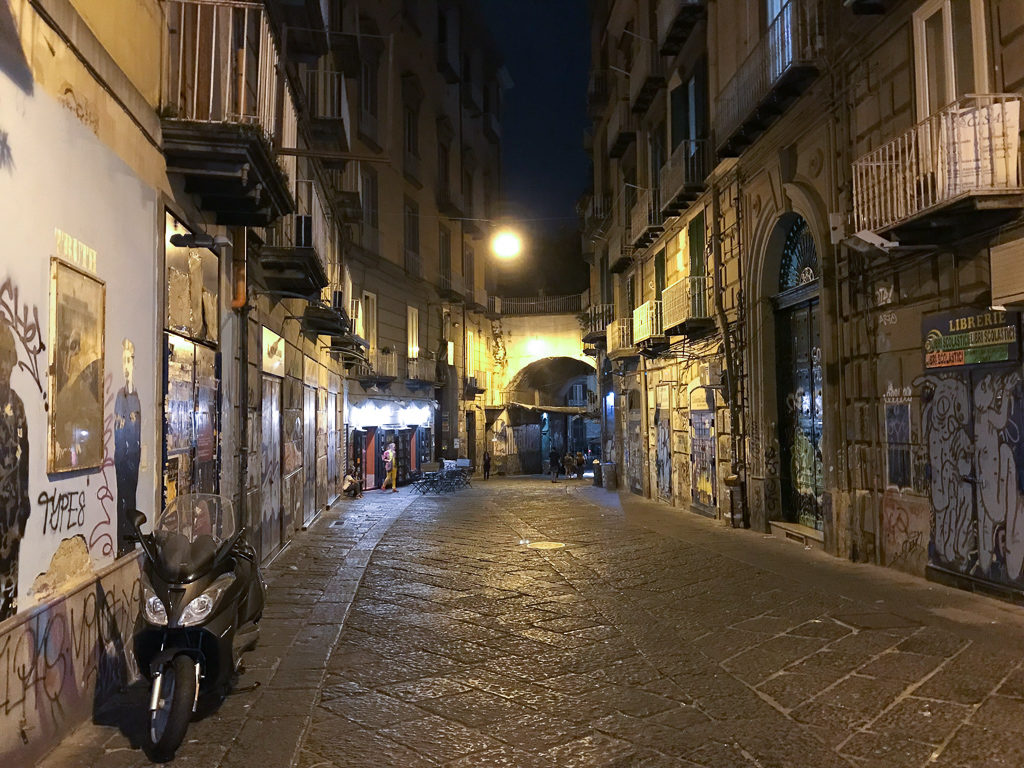
Safety tips for Naples Italy
We found Naples friendly during our stay and didn’t feel threatened. However, we stuck to the same commonsense principles that apply to any big cosmopolitan city where pickpockets and bag snatchers operate eg:
- Don’t wear jewellery, watches or carry expensive bags
- Keep phones, cameras and guidebooks under wraps as much as possible when walking around. Carry a crossbody bag in front of you.
- Keep in mind the distraction tricks that thieves can use. We know people who have been targeted in other cities.
- Stick to the main sightseeing areas and take reliable local advice about the parts of town best avoided by tourists. Check where it’s ok to walk at night – some places (as in many big cities) are off limits. Use a registered taxi if in doubt. Be vigilant in stations and on trains.
Incidentally, there was a noticeable police presence in some squares and busy streets – we’d seen this in Rome too.
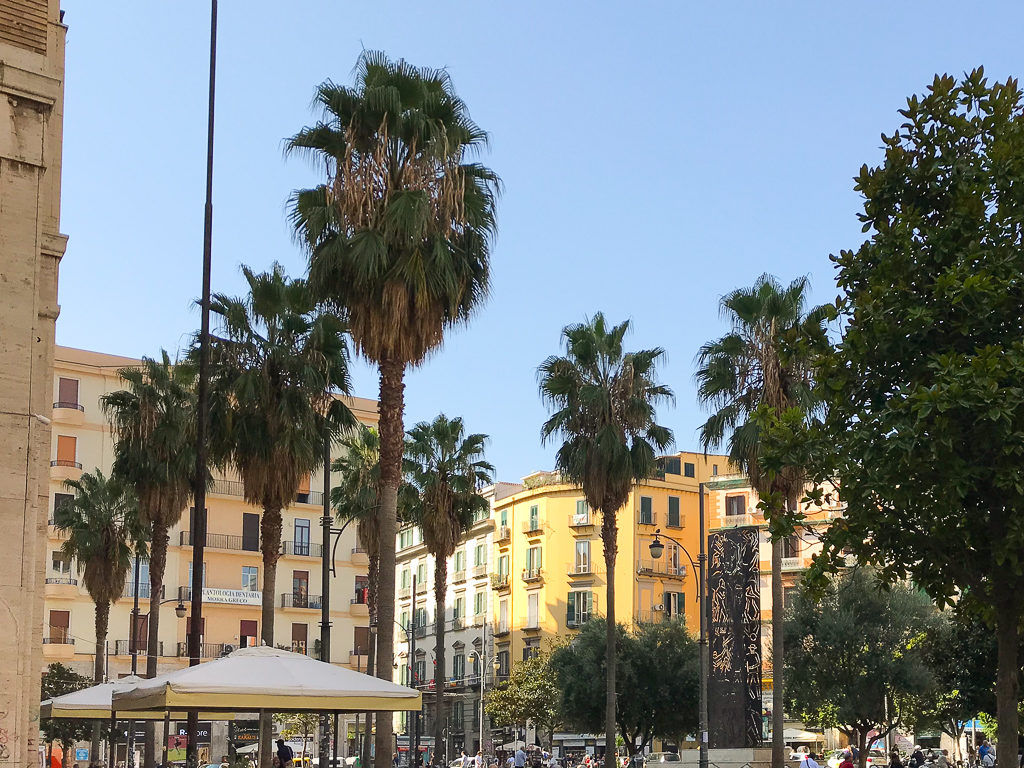
Crossing the street in Naples!
‘See Naples and die’ wrote Goethe in the 1780s. Apparently he was referring to the magnificence of the architecture. He may have also muttered it as he skipped out of the path of a flying horse and carriage.
Crossing the road in Naples requires your full nerve and attention. Pedestrians don’t have right of way at the zebra crossings (black and white stripes across a street). Our best advice is to slipstream the locals since from old ladies to school children they all use the stripes confidently. Traffic does appear to give way if (if!) it has enough time to see you striding purposefully across the road. Hesitate though and that bunch of scooters will race to pass in front and behind you.
We crossed at quiet, narrow points in the street or walked the extra distance to a pedestrian crossing with lights where you’re marginally safer. If you travel to Naples Italy with family you’ll want to brief everyone thoroughly about this!
Should you hire a car in Naples Italy?
No.
Short of parachuting in, I can’t think of a more dramatic way to enter Naples than by taxi on a hot dark Saturday night. The noise, smells and visual cacophony assault you from all sides. Traffic lights only temporarily impede a remorseless surge of cars and scooters.
Our driver plunged through it all with one hand on the wheel and the other holding a phone to his ear so he could have a nice chat at the same time. He charged us 28 euros for the journey from the airport to our apartment. It was more than his original estimate but we were just happy that none of us had been in the driving seat ourselves.
But the traffic is all part of the spirit and energy of Naples! You don’t need a car: pretty much all of the best things to do in Naples Italy can be achieved efficiently using public transport. Our advice is to leave the driving to the locals and sit back and enjoy the views.
Please note that all visitor information here is for guidance only. Please check the relevant websites for the most up to date information eg. accommodation details, tickets, entrance requirements, opening times etc.
What to Read Next
Combine a few days in Naples with rest and relaxation in the hidden seaside gem Maratea, a couple of hours further south. With Amalfi-style views, crystal-clear sea, lovely places to stay – it’s a best-kept Italian secret.
Closer to Naples, is pretty Procida island perfect for a day trip with lovely beaches and pastel-painted villages.
Plan how to visit Pompeii Italy, the ancient Roman town obliterated by a volcanic eruption and still revealing new treasures.
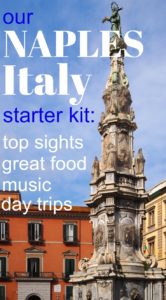
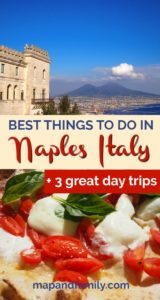
Like this post? Please pin this to save and share to Pinterest!

About the author Nancy Roberts is a former women’s magazine editor and writer. She lives in London and is mum to two 20-something boys. In Map&Family she shares info and inspiration for curious travellers: singles and couples as well as families travelling with teens and young adults.
All photos are all rights reserved. Please do not reproduce these photos without prior written permission
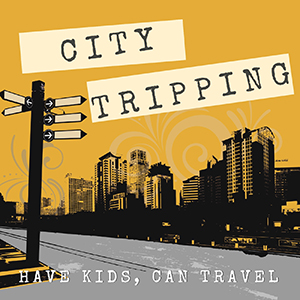

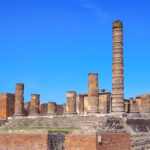
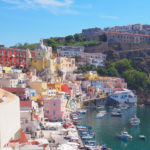
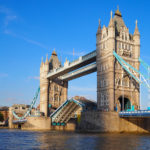
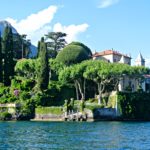
Catherine's Cultural Wednesdays says
Love your car hire advice! I had never thought about Naples as a destination in itself rather than as an airport. …. time to rethink. It sounds stunning and we haven’t visited Pompeii yet either. #CulturedKids
Map & Family says
I’d thought that way too until recently. It really does have a lot to offer, especially for older families who’d like a bit of mystery and grit. And the food is fab and not expensive – which is also great for families!
Scarlett Roitman says
I absolutely love this part of Italy, it’s part grit and part glamour. One of my earliest travel memories was Sorrento and Pompeii with my parents. Never come across Madre but will definitely pay it a visit next time I head over there. Thanks for linking up with #CULTUREDKIDS.
Map & Family says
Completely agree! It’s one of my favourite regions too. Do go to MADRE, worth a visit for the entrance alone!
Trish says
A very enlightening post: so interesting to know more about the city. I had a visit to Naples as a child and only remember the washing and the pizza!
I’m terrible for constantly looking at guide books and maps so will take your tip about keeping them hidden, if I ever return to the city. There’s lots that I’d love to see – even the Metro station is worth a look.
#culturedkids
Map & Family says
It’s a great city! I really want to go back and on the list will be some of the other Art metro stations. Btw I am also guilty of standing in the middle of the street with my nose in a guidebook and a big sign saying ‘tourist not paying attention’ hanging over my head 😂! So I reckon precautions apply in most major tourist places including London.